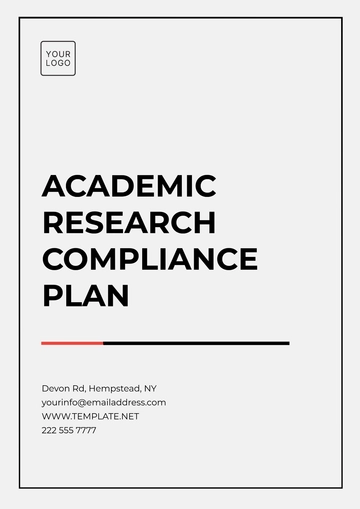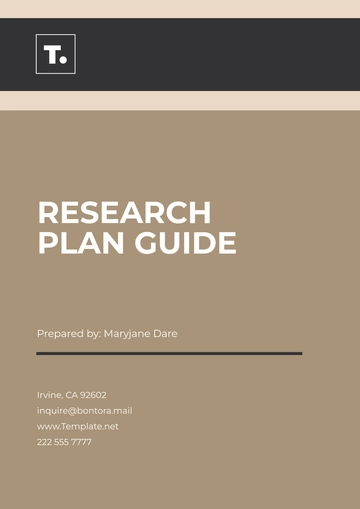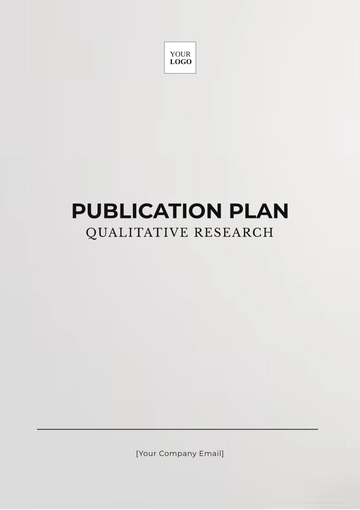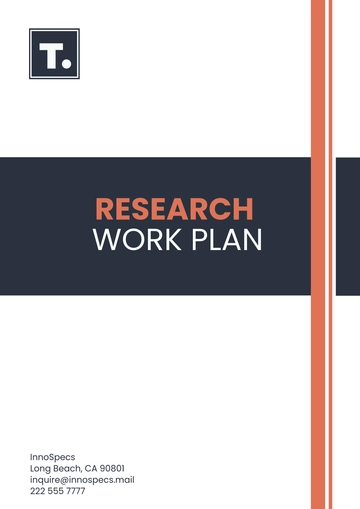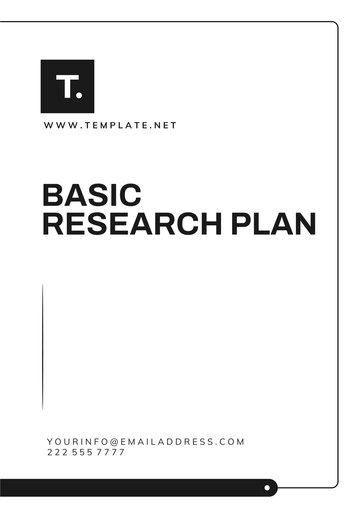Free Science Fair Research Plan

By: [YOUR NAME]
I. Introduction
In the realm of scientific inquiry, the Science Fair Research Plan serves as a foundational document, guiding students through the intricate process of designing and executing a robust scientific experiment. Developed under the mentorship of educators or experienced researchers, these plans instill critical thinking, problem-solving, and research skills essential for success in the scientific community. This document aims to provide a comprehensive template for crafting a meticulous Science Fair Research Plan, ensuring that students embark on their scientific endeavors with clarity, purpose, and methodological rigor.
II. Research Question and Hypothesis
A. Research Question
At the heart of every scientific investigation lies a well-defined research question that elucidates the problem under scrutiny and sets the stage for inquiry. The research question should be clear, concise, and aligned with the objectives of the study. It serves as the guiding beacon, directing the trajectory of the experiment and delineating the boundaries of inquiry.
Sample Research Question:
How does the intensity of light affect the rate of photosynthesis in spinach leaves?
B. Hypothesis
The formulation of a hypothesis represents a critical juncture in the scientific process, where conjecture meets empirical investigation. A hypothesis proposes a tentative explanation for the observed phenomenon, positing a causal relationship between variables. Crafted with foresight and informed by existing knowledge, the hypothesis serves as the cornerstone of the experiment, guiding predictions and hypothesis testing.
Sample Hypotheses:
Null Hypothesis (H₀): There is no significant difference in the rate of photosynthesis between spinach leaves exposed to different intensities of light.
Alternative Hypothesis (H₁): The rate of photosynthesis in spinach leaves will increase with higher light intensity levels.
III. Methodology
A. Experimental Design
The experimental design delineates the blueprint for the investigation, elucidating the procedures, variables, and controls employed to address the research question. It encompasses various elements, including:
Independent Variable: Intensity of light (measured in lumens).
Dependent Variable: Rate of photosynthesis (measured in oxygen production per unit time).
Control Group: Spinach leaves exposed to standard light intensity.
Experimental Group: Spinach leaves exposed to varying light intensities.
Randomization: Random assignment of spinach leaves to experimental and control groups to minimize bias.
B. Materials and Equipment
The selection of appropriate materials and equipment is paramount to the success and validity of the experiment. Careful consideration must be given to the quality, quantity, and suitability of materials, ensuring consistency and reproducibility.
Sample Materials and Equipment:
Item | Quantity | Description | Supplier |
|---|---|---|---|
Spinach leaves | 50 | Fresh spinach leaves | [SUPPLIER NAME] |
Light source | 1 | LED grow light | [SUPPLIER NAME] |
Containers | 10 | Clear plastic containers | [SUPPLIER NAME] |
Water | - | Distilled water | [SUPPLIER NAME] |
Oxygen sensor | 1 | Oxygen sensor | [SUPPLIER NAME] |
C. Procedure
The procedure delineates the step-by-step methodology employed to conduct the experiment, ensuring consistency, reproducibility, and adherence to ethical standards. Each step should be clearly articulated, with precise instructions and safety protocols outlined.
Sample Procedure:
Preparation: Gather all materials and equipment required for the experiment.
Experimental Setup: Place spinach leaves in containers filled with distilled water. Ensure that each container has the same number of leaves.
Light Exposure: Expose the containers to varying intensities of light, ranging from low to high.
Data Collection: Measure the rate of photosynthesis by recording the oxygen production using the oxygen sensor at regular intervals.
Data Analysis: Analyze the data to determine the relationship between light intensity and the rate of photosynthesis.
IV. Data Collection and Analysis
A. Data Collection Methods
Data collection methods encompass the techniques employed to gather empirical evidence and observations pertinent to the research question. These methods should be selected judiciously to ensure the reliability, validity, and relevance of the data collected.
Sample Data Collection Methods:
Quantitative Analysis: Measure oxygen production using an oxygen sensor.
Qualitative Observation: Observe changes in spinach leaf color and vitality.
Controlled Experimentation: Ensure consistency in experimental conditions across groups.
B. Data Analysis
Data analysis encompasses the process of organizing, interpreting, and deriving meaning from the collected data to address the research question and test the hypothesis. It involves a range of statistical and analytical techniques tailored to the nature of the data and the objectives of the study.
Sample Data Analysis Techniques:
Descriptive Statistics: Calculate the mean, median, and standard deviation of oxygen production rates.
Comparative Analysis: Compare oxygen production rates between different light intensity levels.
Correlation Analysis: Assess the correlation between light intensity and photosynthesis rate.
V. Conclusion
In conclusion, this Science Fair Research Plan serves as a vital tool for guiding students through the process of designing and conducting a scientific experiment with precision, rigor, and integrity. By adhering to the principles outlined in this document, students can embark on their scientific endeavors confidently, equipped with the knowledge and skills necessary to navigate the complexities of the scientific process.
- 100% Customizable, free editor
- Access 1 Million+ Templates, photo’s & graphics
- Download or share as a template
- Click and replace photos, graphics, text, backgrounds
- Resize, crop, AI write & more
- Access advanced editor
Enhance your operational efficiency with the Operations Research Template from Template.net. Our customizable and editable solution empowers you to optimize processes effortlessly. Tailor it to your needs using our intuitive AI Editor Tool, ensuring seamless integration into your workflow. Streamline decision-making, maximize resources, and achieve your objectives with ease. Get started today!
You may also like
- Finance Plan
- Construction Plan
- Sales Plan
- Development Plan
- Career Plan
- Budget Plan
- HR Plan
- Education Plan
- Transition Plan
- Work Plan
- Training Plan
- Communication Plan
- Operation Plan
- Health And Safety Plan
- Strategy Plan
- Professional Development Plan
- Advertising Plan
- Risk Management Plan
- Restaurant Plan
- School Plan
- Nursing Home Patient Care Plan
- Nursing Care Plan
- Plan Event
- Startup Plan
- Social Media Plan
- Staffing Plan
- Annual Plan
- Content Plan
- Payment Plan
- Implementation Plan
- Hotel Plan
- Workout Plan
- Accounting Plan
- Campaign Plan
- Essay Plan
- 30 60 90 Day Plan
- Research Plan
- Recruitment Plan
- 90 Day Plan
- Quarterly Plan
- Emergency Plan
- 5 Year Plan
- Gym Plan
- Personal Plan
- IT and Software Plan
- Treatment Plan
- Real Estate Plan
- Law Firm Plan
- Healthcare Plan
- Improvement Plan
- Media Plan
- 5 Year Business Plan
- Learning Plan
- Marketing Campaign Plan
- Travel Agency Plan
- Cleaning Services Plan
- Interior Design Plan
- Performance Plan
- PR Plan
- Birth Plan
- Life Plan
- SEO Plan
- Disaster Recovery Plan
- Continuity Plan
- Launch Plan
- Legal Plan
- Behavior Plan
- Performance Improvement Plan
- Salon Plan
- Security Plan
- Security Management Plan
- Employee Development Plan
- Quality Plan
- Service Improvement Plan
- Growth Plan
- Incident Response Plan
- Basketball Plan
- Emergency Action Plan
- Product Launch Plan
- Spa Plan
- Employee Training Plan
- Data Analysis Plan
- Employee Action Plan
- Territory Plan
- Audit Plan
- Classroom Plan
- Activity Plan
- Parenting Plan
- Care Plan
- Project Execution Plan
- Exercise Plan
- Internship Plan
- Software Development Plan
- Continuous Improvement Plan
- Leave Plan
- 90 Day Sales Plan
- Advertising Agency Plan
- Employee Transition Plan
- Smart Action Plan
- Workplace Safety Plan
- Behavior Change Plan
- Contingency Plan
- Continuity of Operations Plan
- Health Plan
- Quality Control Plan
- Self Plan
- Sports Development Plan
- Change Management Plan
- Ecommerce Plan
- Personal Financial Plan
- Process Improvement Plan
- 30-60-90 Day Sales Plan
- Crisis Management Plan
- Engagement Plan
- Execution Plan
- Pandemic Plan
- Quality Assurance Plan
- Service Continuity Plan
- Agile Project Plan
- Fundraising Plan
- Job Transition Plan
- Asset Maintenance Plan
- Maintenance Plan
- Software Test Plan
- Staff Training and Development Plan
- 3 Year Plan
- Brand Activation Plan
- Release Plan
- Resource Plan
- Risk Mitigation Plan
- Teacher Plan
- 30 60 90 Day Plan for New Manager
- Food Safety Plan
- Food Truck Plan
- Hiring Plan
- Quality Management Plan
- Wellness Plan
- Behavior Intervention Plan
- Bonus Plan
- Investment Plan
- Maternity Leave Plan
- Pandemic Response Plan
- Succession Planning
- Coaching Plan
- Configuration Management Plan
- Remote Work Plan
- Self Care Plan
- Teaching Plan
- 100-Day Plan
- HACCP Plan
- Student Plan
- Sustainability Plan
- 30 60 90 Day Plan for Interview
- Access Plan
- Site Specific Safety Plan
